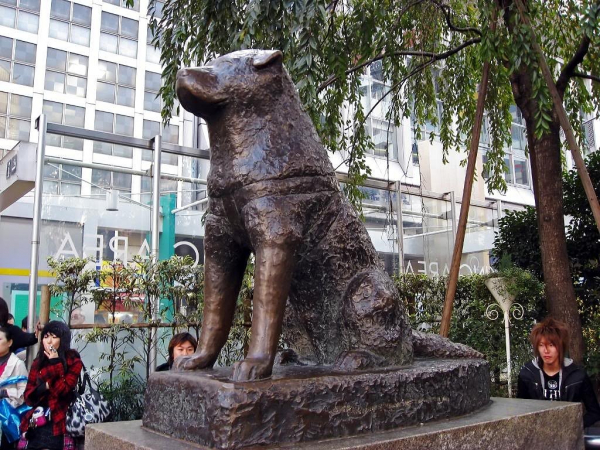Liščí kočka - nově objevený druh na Korsice
Když se mýtus stane realitou. I tak bychom mohli nazvat objevení nového druhu kočky, o které se staletí jen tradovalo.
In this cycle, we will get to know interesting dog personalities. Dogs play an important role in our life, so let us take a look what they have already achieved during our life together. We should find Hachiko in the dictionary next to the phrase “devoted as a dog”. Thanks to this, he is forever inscribed in the heart of (not only) Japan.


Generally, we see the dog as a loyal companion and defender. But Hachiko epitomized this idea in a literal manner, and that’s why the whole world knows him today.
The breed called Akita Inu, which Hachiko belonged to, is one of the oldest – they have been companions of people for 7,000 years at the minimum – and in Japan, they are a very honoured breed. In the past, it was their task to accompany the nomads and to hunt bears and deer. In Japan, this breed became a symbol of luck and loyalty. At the beginning of the twentieth century, it has even been declared a cultural wealth and national treasure.
Hachiko has become famous precisely owing to his loyalty towards his master, even years after his death. The tale about him has spread not only from his hometown of Odate in the Akita prefecture, but also from Japan into the whole world.
Contrary to Laika, which we have introduced last month, Hachiko lived up to the beautiful (even if not much more joyful) 12 years of age (1923-1935). As a puppy, he was adopted by Hidesaburó Ueno, a professor of the Faculty of Agriculture at the Tokio University. Every day, when his master went to the university, Hachiko went along with him to the Shibuya railway station and would wait for him there every evening.
However, one year later, the professor suddenly died at the workplace. The dog got was taken into care of the next of kin, but he kept running away and returning to his master’s house. In the end, there was no other option, and the care for Hachiko was taken over by the professor’s gardener, who had known the dog since he was a puppy. Hachiko’s loyalty to his master, however, didn’t fade away even after all those years, and all the time up to his death nine years later, he would return to the railway station every day, hoping, that his master would finally come back.
Interest of the whole Japan in Hachiko was awakened by one of the articles by the former student of professor Uen, which focused exactly on the extraordinary loyalty of this dog. And this way, Hachiko became a model example of loyalty in 1932, his tale moved everyone and the interest in the Akita Inu breed increased.
In his memory, Hachiko’s bronze statue is standing on this railway station until today and it is still waiting, when his master will be coming home. Even two films have been made about his life, one Japanese film called Hachiko and then a British-American remake Hachiko: A Dog’s Story. Hachiko’s remains are deposited in the National Museum of Science in Tokyo and the legend about this immortal bond and about how even the commonest ritual may become the greatest and purest confession of love has been handed down in Japan until today.


Když se mýtus stane realitou. I tak bychom mohli nazvat objevení nového druhu kočky, o které se staletí jen tradovalo.


Udržitelnost a ekologie jsou témata, o která se zajímá stále více lidí. A protože spousta takových lidí bydlí doma s kočkou, je na čase se podívat, jak jde udržitelný způsob života praktikovat v péči o mazlíčky.


Ačkoli se o své mazlíčky staráme s láskou a nejlépe jak umíme, mohou nastat situace, kdy jsou na léčbu psa nebo kočky potřeba i desetitisíce korun. A pojištění - stejně jako u lidí - může být v takovém případě řešení.


Měli byste si dávat pozor, kam se doma díváte. Vědci totiž prokázali, že kočky dokáží správně určit a vyhodnotit lidský pohled. Kromě nich byl tento druh chování zjištěn také u psů.


Pokud chcete dát psovi víc než jen kus dobroty, odměnu nebo pochvalu, ale rádi byste, aby pamlsek psovi i nějak přispěl ke zdraví, je čas poohlédnou se po funkčních pamlscích. Jde vlastně o doplněk stravy a pamlsek v jednom, jak už jejich název...


Psi strčí svůj zvědavý čumák kdekam, a tak se v létě lehce může stát, že (nejen oni) dostanou včelí nebo vosí žihadlo. Jak v takovém případě postupovat?


Často slýchám, že brambory jsou pro psy jedovaté. Jak je tedy možné, že se často objevují ve složení kvalitních psích krmiv? Jsou pro psy škodlivé, vhodné, nebo dokonce prospěšné?


Plemeno bengálské kočky vzniklo poměrně nedávno křížením domácích a divokých koček. Díky tomuto spojení získalo vzhled připomínající kočky z pravěku, za což může hlavně jejich tečkovaná kresba.


Někteří z nás o prázdninách vyrážejí k moři a vyvstává otázka, zda vzít naše psí parťáky s sebou, nebo je raději nechat doma. Jedním z aspektů při rozhodování může být otázka, co pes a moře. Uškodí sůl ve vodě chlupáčovu kožichu, nebo je to zbytečná...


Tito bratři bišonků jsou skvělí společníci snad pro každého. Bez problémů si s nimi poradí i člověk bez jakékoli zkušenosti se psy. Mají skvělou povahu, nevyžadují skoro žádnou péči, lehce se cvičí a zdraví jim slouží. Ke štěstí jim stačí jen...


Dnešní doba tíhne ke zdravé výživě, a to i ve světě domácích mazlíčků. Páníčci se více zajímají, co svým zvířecím společníkům servírují, což je jedině dobře. Jaké chyby ale stále často děláme?


Léto je tu a s ním i období dovolených. Pokud se na cestu vydáte se svým čtyřnohým miláčkem, nesmíte mu zapomenout zabalit pár nezbytných věcí. Pokusím se shrnout praktické rady a věci, které by v tašce pro pejska neměly chybět.